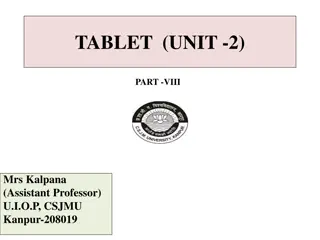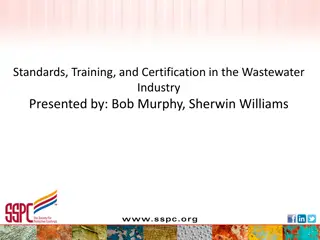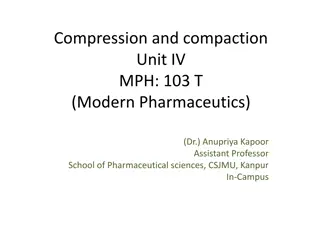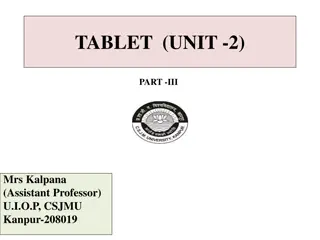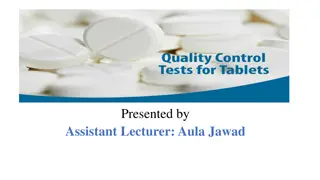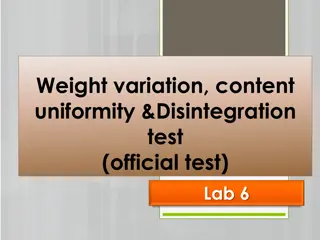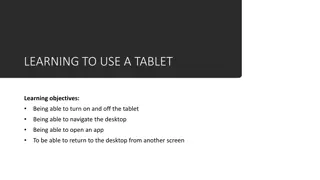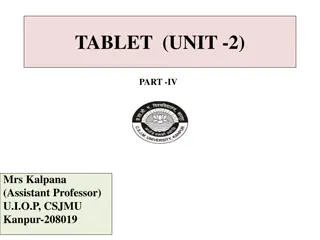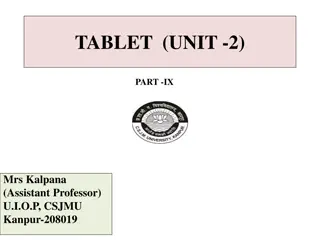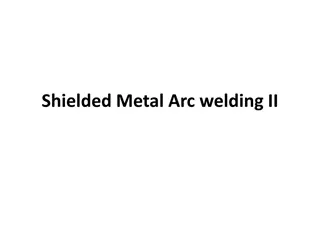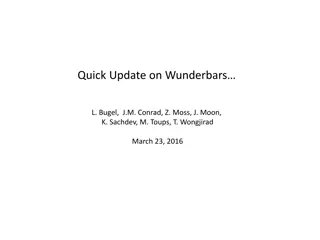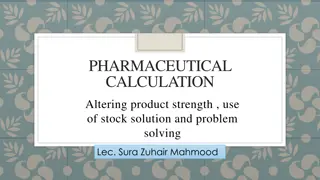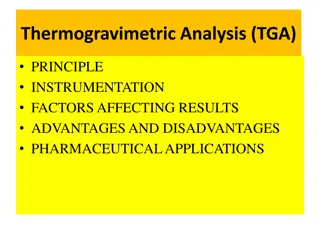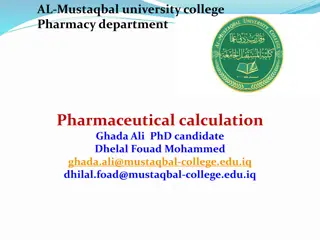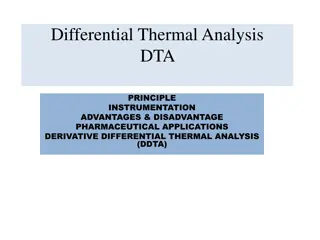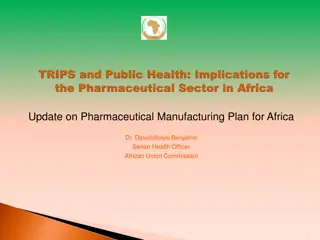Understanding Tablet Coating in Pharmaceutical Sciences
Tablet coating is a vital process in pharmaceutical manufacturing, providing benefits such as masking taste and odor, protecting the drug, and enhancing stability. Various types of coatings are used, including sugar coating, film coating, and specialized coatings, each with its advantages and disadvantages. The sugar coating process involves applying sugar-based solutions to tablets, requiring skill and specific equipment. While sugar coating has advantages like being cost-effective and safe, it is a time-consuming process with some drawbacks.
Download Presentation

Please find below an Image/Link to download the presentation.
The content on the website is provided AS IS for your information and personal use only. It may not be sold, licensed, or shared on other websites without obtaining consent from the author. Download presentation by click this link. If you encounter any issues during the download, it is possible that the publisher has removed the file from their server.
E N D
Presentation Transcript
Tablet Coating Dr. Kalpana Assistant Professor School of Pharmaceutical Sciences CSJMU Kanpur
TABLET COATING Tablet coating is the application of coating material to the exterior of a tablet with the intention of conferring benefits and properties to a dosage form over the uncoated variety. As per I.P, Tablet coated with mixture of various substances such as resins, gums, inactive and insoluble fillers, sugars, waxes, etc.
Why To Coat Mask Bitter taste Mask unpleasant odour. Protecting the drug from surroundings. To increase the Stability. Handling & ease of ingesting by patients. Mechanical protection from breakage. Avoid Light incompatibility. Protection from Environmental Oxidation. In- elegent core. To modifying the drug release profile. For Product identity.
Types of coating Sugar coating Film coating Enteric coating Controlled release coating Specialized coating a. Compressed coating b. Electrostatic coating c. Dip coating d. Vacuum film coating
Tablet Coating Process Spraying Wetting Recrystallisation Coated Particle
Sugar Coating Sugar coating is the most conventional multistep coating process. As the name suggests, this process involves application of sugar (sucrose) based coating solution to the tablets. It is carried out in coating pans having variable capacities & mounted at an angel of 40 degree Its use of labour is more, require a fair degree of skill.
Advantages of Sugar Coating Cheap safe coating material cheap coating machine good patient compliance can be reprocessed require less hardness core
Disadvantages of Sugar Coating time consuming process. high weight gain. increase in packaging & shipping. required trained personnel. Imprinting problems.
Raw Materials of Sugar Coating 1. Sugar & it s Subtituents: Glucose, lactose, isomalt, sugar alcohols 2. Binders: Acacia, gelatin, PVP 3. Coloring agents: Water soluble (dyes), water insoluble (lakes) 4. Anti-Adherents: Talcum, colloidal silica 5. Fillers: CaCO3, CaSO4, starch, talcum, TiO2 6. Polishing Agents: beeswax, carnauba wax, paraffin 7. Other agents: Flavouring agents, surfactants
Steps involved in Sugar Coating Sealing/ Grossing/ Polishing/ Sub-coating Coloring Printing Seal coating Smoothing Finishing
Steps involved in Sugar Coating SEAL COATING SUBCOATING GROSSING/SMOOTHIN to prevent water from coating solution to prevent migration from core to produce enteric coating (some cases) to reduce core abrasion to round off sharp edge of core (smooth surface is not required) to provide a good substrate for subsequent smoothing step to smooth the rough core surface. COLOURING POLISHING/FINISHING to provide a smooth base for color coat to enhance gloss. to provide moisture protection. Steps involved in Sugar coatingSteps involved in Sugar coating
FILM COATING Film coating is deposition of a thin film of polymer surrounding the tablet core. The polymer is solubilized into solvent then other additives like plasticizers and pigments are added. Resulting solution is sprayed onto a tablet bed and then drying process is carried out giving thin deposition of coating material around each tablet Advantages 1. Film coating gives a tablet with less Weight and small size. 2. The film formed is very thin. 3. In film coating engravings are possible on tablet surface which are not possible in sugar coating 4. Better mechanical strength is obtained. 5. The cost of the film coated tablets is less
IDEAL PROPERTIES OF FILM COATING MATERIAL It should be soluble in a solvent of choice. It must produce an elegant coat. It should be stable in presence of heat, light or moisture. It should not possess disagreeable (unpleasant) color, taste or odor. It should be non-toxic and pharmacologically inert. It should be compatible with coating additives
FILM FORMING AGENTS Film forming agents Non - enteric film formers Enteric film formers
Enteric film formers CAP(Cellulose acetate phthalate) Acrylate Polymers HPMCP( Hydroxypropyl methyl cellulose phthalate) PVAP(Polyvinyl acetate phthalate)
Defects Sticking and picking : When the coating solution overwets, the tablets stick to each other or to the coating pan. On drying , a piece of film may remain adhered to pan or another tablet. Solution : It can be solved by reducing the liquid application rate or increasing the dry air temperature and volume Orange-Peel effect : When the coating solution is sprayed inadequately or improperly before drying causes a bumpy or Orange- Peel effect on the coating. Solution : This can be solved by thinning the solution with additional solvent Bridging and Filling : This is observed in tablets consisting of monogram or bisection. During drying, the film may shrink and pull away from sharp corners resulting in Bridging of the surface depression. Filling is caused when too much of solution is applied which fills and narrows the monograms or bisect. Solution : Bridging can be solved by increasing the plasticizer content or changing the plasticizer
Defects Blistering : When coated tablets require further drying in ovens, too rapid evaporation of solvent from core and the effect of high temperature may effect the strength, elasticity and adhesion properties of the film results in blistering. An unsmooth film surface shows a number uneven spots called blisters. Solution : It can be solved by employing milder drying conditions. Dull film (Bloom) : This happens when high temperatures are used in formulations. It can also happen when the coated tablets are exposed to high humidity conditions and also due to migration of plasticizers to the surface of coat. Colour Variation : It is caused by processing conditions of formulations , improper mixing, uneven spray pattern and insufficient coating may result colour variation Cracking : Cracking occurs due to internal stresses that occur in the film. If internal stress exceeds the tensile strength, cracking occurs. This can be solved by adjusting the type and concentration of plasticizer.
REFERENCES Theory and practice of Industrial Pharmacy by Liberman Lachman https://www.slideshare.net/prkppt/tablet-coating-75460106 https://www.slideshare.net/yagnikankita/tablet-coating-by-ankita- yagnik https://www.slideshare.net/kiranmaikuppala/tablet-coating- 46606341 https://www.slideshare.net/bhanu_biswas/tablet-coating-9422859


